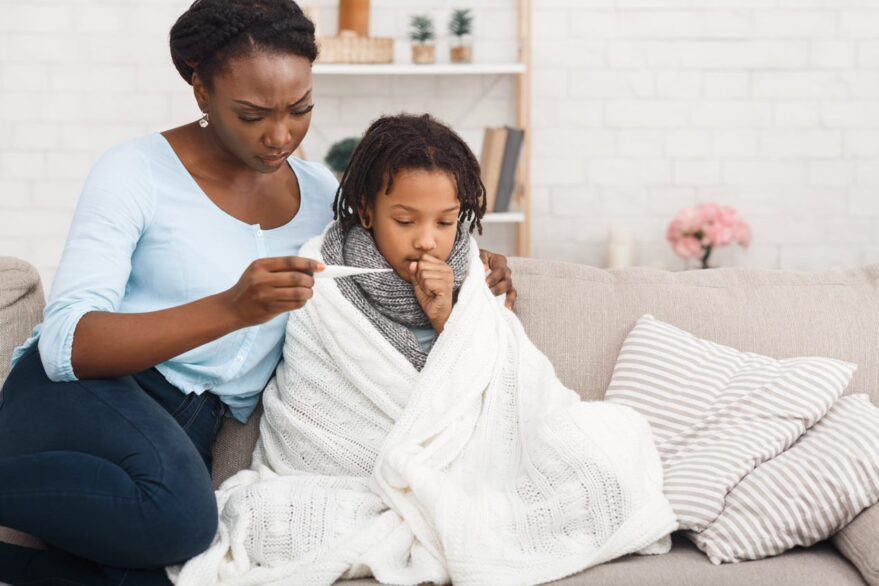It’s that time of year again. Cold and flu season. And with kids returning to normal activities like school, daycare, activities and playdates, cases of all respiratory diseases are up this year. Rady Children’s Hospital-San Diego, shares tips on differentiating the various illnesses, prevention tips, how to care for symptoms at home and what you want in your medicine cabinet ahead of the season.
Respiratory syncytial virus (RSV)
RSV is a common respiratory virus that usually causes mild, cold-like symptoms. Nearly all U.S. children normally catch an RSV infection by age 2. General symptoms include a runny nose, decrease in appetite, coughing, sneezing, fever and wheezing. Most children and adults recover in one to two weeks. However, some children, especially babies, can get an illness called bronchiolitis. This causes a lot of mucous, congestion and potentially wheezing. If your child is struggling to breathe, have them seen by a doctor. Learn more about RSV, here.
Flu
Symptoms of the flu can include sudden onset of high fever, headaches, sore throat, body aches, cough and fatigue. Some children may also experience belly pain, nausea, vomiting or diarrhea. Most people recover from the flu with plenty of rest and liquids.
High-risk children for complications from influenza may need an antiviral drug. Antiviral drugs (such as Tamiflu) are sometimes used to treat influenza. They must be started within 48 hours when the flu symptoms start. The benefits are limited. Tamiflu reduces the time your child is sick by 1 to 2 days. It helps reduce symptoms but does not make them go away. Contact your pediatrician for more information. Learn more about influenza, here.
COVID-19
COVID-19 affects different people in different ways and symptoms can be mild to severe. Symptoms may include fever or chills, cough, shortness of breath or difficulty breathing, fatigue, muscle or body aches, headache and new loss of taste or smell, among other things. The flu and COVID-19 have similar symptoms, making it tricky to differentiate. The only way to be certain that you have COVID-19 is to take a test. Learn more about COVID-19, here.
Cold/General Fever/Unknown
Colds are generally milder than the flu, RSV or COVID-19 and include respiratory symptoms, such as a scratchy throat, runny or stuffy nose or sneezing. If there is a fever, it’s usually low-grade. Most people recover from a cold in about a week. Many fall and winter viral infections cause mild symptoms, including fever and there are ways to care for these symptoms at home. Learn more about colds, here.
Home care tips:
- To help with runny nose and mucus:
-
- Have your child blow their nose into a clean tissue or use a suction bulb/suction device to suction the mucus
- Use nasal saline
- Take a warm shower or bath to loosen mucus
- Use a humidifier, as moist air keeps the nose and airway from drying out
- To help with cough or sore throat:
- Younger than 1 year old, try giving warm, clear liquids like apple juice (1-3 teaspoons, 4 times per day)
- Older than 1 year old, try honey. This can be off a teaspoon or mixed with warm liquids.
- American Academy of Pediatrics does not recommend over-the-counter (OTC) cough and cold medicines for children younger than 4 years. The Medical Academy says that Children 4 to 6 years of age should only use OTC cough and cold medicines if a doctor says it is OK.
- To help with a low-grade fever (above 98.6° F but lower than 100.4 degrees F):
- Take a lukewarm bath
- Wear light pajamas
- Stay well hydrated
- Rest
- Use fever-reducing medicines, either acetaminophen or ibuprofen, for fevers over 102 degrees F (never give your child aspirin)
- If you get concerned about your child’s fever for any reason, call your pediatrician
- General tips:
- Drink lots of fluids and stay well hydrated
- Get plenty of rest
What to stock in the medicine cabinet this cold and flu season:
- Fever and pain reducers, both acetaminophen and ibuprofen
- Tissues
- Nasal saline drops or spray
- Hand sanitizer
- Bulb or nose suction device to help clear mucus
- COVID-19 tests
- Electrolyte drinks, flavored gelatin and popsicles
When to seek care:
Call your health care provider if:
- Breathing difficulty occurs
- Fever is 103 F (39.4 C) or higher
- Fever lasts more than 3 days
- Blue color to the skin
- Retractions (pulling in between the ribs)
- Dehydration
- Severe earache or sinus pain
- Nasal discharge lasts more than 2 weeks
- Cough lasts more than 3 weeks
- Your child is HIGH-RISK (i.e., asthma, diabetes, heart disease, cancer) and exposed to influenza or develops symptoms of influenza
Need help determining where to get care? Check out our care diagram, here.
Prevention:
- Vaccination is your greatest ally this season. Both flu and COVID-19 vaccines are available now for all ages. Vaccines can protect kids from contracting the virus and reduce the risk of severe symptoms.
- Wash hands frequently
- Avoid exposure when possible
- Keep things clean – sanitize doorknobs, countertops, phones and handles
- Don’t share plates, cups or utensils with others
- Wash toys regularly
- Eat healthy and drink plenty of water or clear fluids
